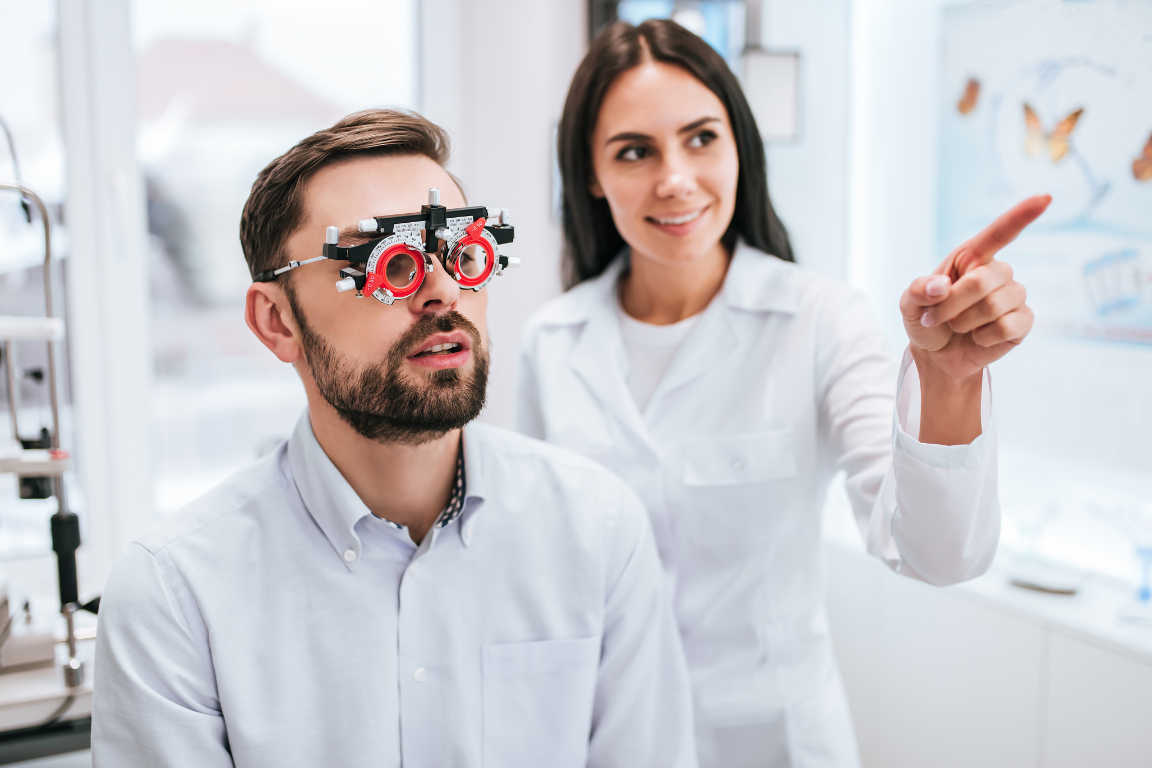With the new year comes the opportunity to start afresh. For optometrists and practice owners, this might mean 2024 is the year of better work-life balance, focusing on attracting new patients, or finally taking the plunge into further study. Entering into the new year could also be a great chance to debunk all those eyecare myths floating around – these don’t need to follow your patients into 2024. Give your patients the belated Christmas gift of accurate eyecare education.
Here are 10 popular eye and vision-related misconceptions to tell your patients to leave behind in 2023.
1. Eating carrots will give me super night vision.
The origins of this common myth are allegedly rooted in a British ploy to hide their radar technology advantage from German troops during World War II. The Airborne Interception Radar enabled the British air force to target enemy planes in the dark. However, to keep this secret, the Ministry of Information fed the media the story that this uncanny ability to pinpoint German bombers at night was due to a diet in excess of carrots.1
A 2020 survey by Optometry Australia found that one-third of Australians believed eating carrots would actually improve their eyesight2 – WWII British propaganda is evidently still going strong today! Of course, optometrists understand that while carrots are rich in beneficial nutrients such as beta carotene, vitamin C, and vitamin E,3 they will not confer superhuman night vision or fend off the need for glasses.4
2. Wearing reading glasses will weaken my near vision.
Many an optometrist has encountered an early presbyopic 45-year-old patient refusing to wear reading glasses on the premise that once they start wearing them, they won’t be able to stop. That the eyes will weaken and develop a dependency on glasses is a pervasive misconception.
It may help to politely point out that your patient’s current struggles with their near vision have obviously developed on their own without having worn any reading glasses previously. An explanation about the natural progression of ageing on accommodation with or without succumbing to wearing reading glasses can also help to explain away this myth.
3. Reading in low light will ruin my eyes.
Another age-old myth that reading in the dark will damage eyesight, resulting in the need for glasses. While it is known that light exposure plays a role in myopia development in children,5 there is currently no evidence that reading in the dark causes any permanent ocular damage. Instead, you may counsel your patients that near work in dim lighting can lead to temporary headaches, eyestrain, and visual fatigue.4
4. Having 6/6 vision means my eyes are perfectly healthy.
Many patients believe that 6/6 visual acuity equates to perfect vision, however, optometrists know there is much more to vision than VA. Not to be a Negative Nellie, but this is a good opportunity to remind your patients that they can have 6/6 acuity yet still have glaucoma or a squamous cell carcinoma.
5. If the contact lenses I ordered online seem clear, I don’t need to see my optometrist.
Online contact lens sales are currently poorly regulated in Australia,6 allowing patients to purchase lenses without a valid prescription or relying on the patient to answer truthfully about the validity of their script. It’s every patient’s prerogative to purchase their contacts from wherever they want. However, reminding them that contact lenses are a medical device that requires regular review with an eyecare professional can encourage them to maintain the relationship with your practice.
6. Contact lenses are only for adults.
Even contact lens-wearing parents can be surprised to hear that children can successfully wear contact lenses too. Facts to point out include that studies have found contact lenses can improve self-esteem as well as increasing social confidence and participation in physical activities,7 without any increased risk of adverse events compared to adult wearers.8 Not to mention, contact lenses play an important role in managing progressive myopia in the paediatric population.9
7. Short-sightedness in children is just a vision problem that can be fixed with glasses.
While Australian optometrists boast the highest rates of proactively addressing progressive myopia around the world,10 there is still some way to go with educating parents of myopic children. One survey found that 67% of parents were concerned about their child developing myopia or their myopia progressing. However, 37% of these concerns were due to the dependence on optical correction, and 14% due to the financial cost of purchasing glasses and contacts.11 Though these are not trivial factors, parents of at-risk children should also be educated of the ocular health consequences of myopia.
8. I only need to get a check-up with an optometrist if I notice issues.
An oldie but a goodie – and every optometrist’s job to educate their patients otherwise. This may be your chance to remind patients that many eye diseases begin with no noticeable or bothersome symptoms. Think glaucoma, cataracts, even age-related macular degeneration, and diabetic retinopathy. Having “issues” is also a fairly subjective experience and shouldn’t be the standard by which a patient decides they need an examination.
9. Expensive spectacle lenses are the same as cheap spectacle lenses.
It’s generally true that you get what you pay for, and the same goes for spectacle lenses. Patients can be counselled on the factors that contribute towards the cost of premium lenses. For example, the customisation involved in developing a freeform progressive lens that offers comfortable clarity with minimal peripheral aberration will result in a dearer lens compared to a headache-inducing first-generation multifocal design.
You are always going to get patients who are genuinely on a budget, but there are also a number of sceptics who feel you’re just trying to upsell them. Know your product and be prepared to explain the difference in features between lenses of different price points.
10. Systemic medications don’t have any effect on the eyes.
Despite the eyes being decidedly connected to the rest of the body, some patients don’t realise that their systemic medications can have ocular side effects. This can lead to neglecting to mention such medications during the history component of an eye exam. Optometrists can ensure they clarify that they need to know about all medications, not just those specifically for the eyes. Common medications with known ocular adverse effects include amiodarone, allopurinol, antihistamines, chloroquine and hydroxychloroquine, and oral steroids.12
Summary
As 2024 kicks into gear, it’s a good reminder about the role optometrists play in educating the Australian public about eyecare. Who knows, these conversations may save an eye or two this year.
References
- Smithsonian Magazine. A WWII Propaganda Campaign Popularised the Myth that Carrots Help You See in the Dark. https://www.smithsonianmag.com/. 2013. Available at: https://www.smithsonianmag.com/arts-culture/a-wwii-propaganda-campaign-popularized-the-myth-that-carrots-help-you-see-in-the-dark-28812484/. (Accessed January 2024).
- Optometry Australia. The 2020 Vision Index report is live. https://www.optometry.org.au/. 2020. Available at: https://www.optometry.org.au/research_surveys/the-2020-vision-index-report-is-live/. (Accessed January 2024).
- Food Standards Australia New Zealand. F002276: Carrot, mature, peeled, fresh, raw. https://afcd.foodstandards.gov.au/. Available at: https://afcd.foodstandards.gov.au/fooddetails.aspx?PFKID=F002276. (Accessed January 2024).
- American Academy of Ophthalmology. 20 Eye and Vision Myths. https://www.aao.org/. 2022. Available at: https://www.aao.org/eye-health/tips-prevention/common-eye-vision-myths-facts. (Accessed January 2024).
- Landis E, Yang V, Brown D, et al. Dim Light Exposure and Myopia in Children. Invest. Ophthalmol. Vis. Sci.2018;59(12):4804-4811.
- Optometry Australia. Optometry Australia concerned at the rise of unvalidated online contact lens sales. https://www.optometry.org.au/. 2019. Available at: https://www.optometry.org.au/patient_care_management/optometry-australia-concerned-at-rise-of-unvalidated-online-contact-lens-sales/. (Accessed January 2024).
- CDC. Children and Contact Lenses. https://www.cdc.gov/. 2021. Available at: https://www.cdc.gov/contactlenses/children-and-contact-lenses.html. (Accessed January 2024).
- Chalmers RL, McNally JJ, Chamberlain P, Keay L. Adverse event rates in the retrospective cohort study of safety of paediatric soft contact lens wear: the ReCSS study. Ophthalmic Physiol Opt. 2021;41(1):84-92.
- My Kids Vision. Soft contact lenses for myopia control in children. https://www.mykidsvision.org/. 2022. Available at: https://www.mykidsvision.org/knowledge-centre/soft-contact-lenses-for-myopia-control-in-children#:~:text=Myopia%20control%20contact%20lenses%20are,to%20slow%20progression%20of%20myopia. (Accessed January 2024).
- Mivision. Strong Foundations and Fresh Research in Myopia Management. https://mivision.com.au/. 2023. Available at: https://mivision.com.au/2023/12/strong-foundations-and-fresh-research-in-myopia-management/. (Accessed January 2024).
- Ortiz-Peregrina S, Solano-Molina S, Martino F, Castro-Torres JJ, Jiménez JR. Parental awareness of the implications of myopia and strategies to control its progression: A survey-based study. Ophthalmic Physiol Opt. 2023; 43: 1145–1159.
- Australian Prescriber. The ocular adverse effects of oral drugs. https://australianprescriber.tg.org.au/. 2021. Available at: https://australianprescriber.tg.org.au/articles/the-ocular-adverse-effects-of-oral-drugs.html. (Accessed January 2024).




